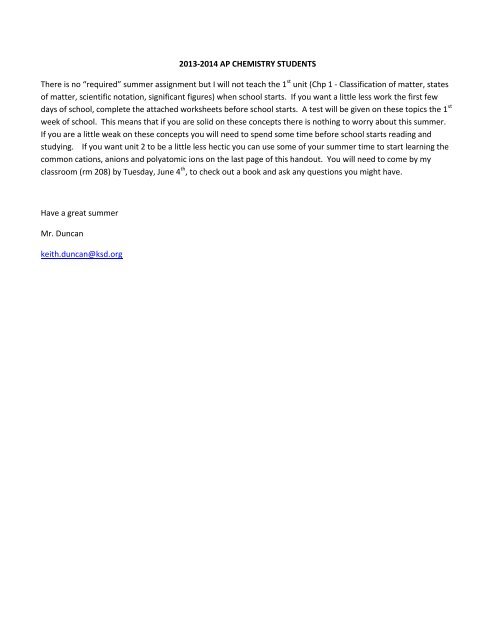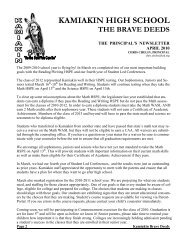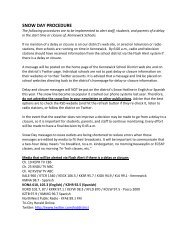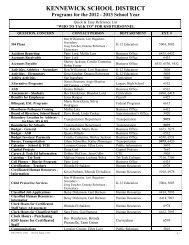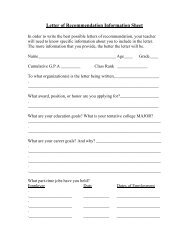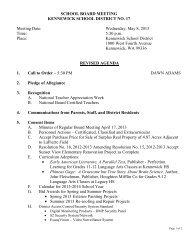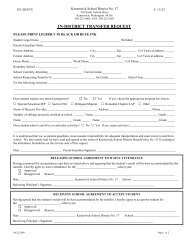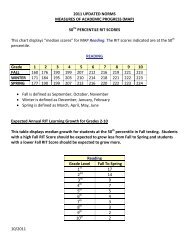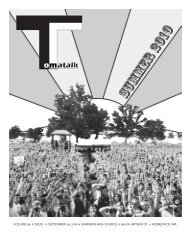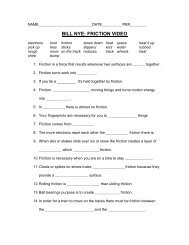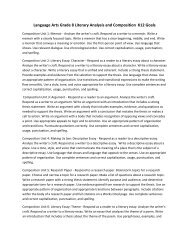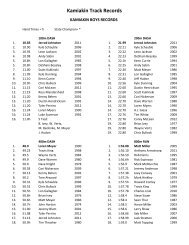AP CHEM
AP CHEM
AP CHEM
Create successful ePaper yourself
Turn your PDF publications into a flip-book with our unique Google optimized e-Paper software.
2013-2014 <strong>AP</strong> <strong>CHEM</strong>ISTRY STUDENTS<br />
There is no “required” summer assignment but I will not teach the 1 st unit (Chp 1 - Classification of matter, states<br />
of matter, scientific notation, significant figures) when school starts. If you want a little less work the first few<br />
days of school, complete the attached worksheets before school starts. A test will be given on these topics the 1 st<br />
week of school. This means that if you are solid on these concepts there is nothing to worry about this summer.<br />
If you are a little weak on these concepts you will need to spend some time before school starts reading and<br />
studying. If you want unit 2 to be a little less hectic you can use some of your summer time to start learning the<br />
common cations, anions and polyatomic ions on the last page of this handout. You will need to come by my<br />
classroom (rm 208) by Tuesday, June 4 th , to check out a book and ask any questions you might have.<br />
Have a great summer<br />
Mr. Duncan<br />
keith.duncan@ksd.org
© Adrian Dingle’s Chemistry Pages 2004, 2005, 2006, 2007, 2008, 2009, 2010. All rights reserved.<br />
These materials may NOT be copied or redistributed in any way, except for individual class instruction.<br />
Revised August 2009<br />
<strong>AP</strong> Common Ions<br />
CATIONS (+ve)<br />
ANIONS (-ve)<br />
Name<br />
Symbol/<br />
Formula<br />
Alternative*<br />
Name<br />
Symbol/<br />
Formula<br />
Alternative*<br />
Aluminum Al 3+ Bromide Br -<br />
Ammonium<br />
+<br />
NH 4 Bromate (I) BrO - (Hypobromite)<br />
Arsenic (III) As 3+ Bromate (III)<br />
-<br />
BrO 2 (Bromite)<br />
Arsenic (V) As 5+ Bromate (V)<br />
-<br />
BrO 3 (Bromate)<br />
Barium Ba 2+ Bromate (VII)<br />
-<br />
BrO 4 (Perbromate)<br />
Bismuth (III) Bi 3+ Carbonate<br />
2-<br />
CO 3<br />
Bismuth (V) Bi 5+ Chlorate (I) ClO - (Hypochlorite)<br />
Cadmium Cd 2+ Chlorate (III)<br />
-<br />
ClO 2 (Chlorite)<br />
Calcium Ca 2+ Chlorate (V)<br />
-<br />
ClO 3 (Chlorate)<br />
Chromium (II) Cr 2+ Chlorate (VII)<br />
-<br />
ClO 4 (Perchlorate)<br />
Chromium (III) Cr 3+ Chloride Cl -<br />
Cobalt (II) Co 2+ Chromate<br />
2-<br />
CrO 4<br />
Cobalt (III) Co 3+ Cyanide CN -<br />
Copper (I) Cu + (Cuprous) Dichromate<br />
2-<br />
Cr 2O 7<br />
Copper (II) Cu 2+ (Cupric) Dihydrogen Phosphate<br />
-<br />
H 2PO 4<br />
Hydrogen H + Ethanoate<br />
-<br />
C 2H 3O 2 (Acetate)<br />
Hydronium H 3O + Fluoride F -<br />
Iron (II) Fe 2+ (Ferrous) Hydride H -<br />
Iron (III) Fe 3+ (Ferric) Hydrogen Carbonate<br />
-<br />
HCO 3 (Bicarbonate)<br />
Lead (II) Pb 2+ (Plumbous) Hydrogen Oxalate<br />
-<br />
HC 2O 4 (Binoxalate)<br />
Lead (IV) Pb 4+ (Plumbic) Hydrogen Phosphate<br />
2-<br />
HPO 4<br />
Lithium Li + Hydrogen Sulfate<br />
-<br />
HSO 4 (Bisulfate)<br />
Magnesium Mg 2+ Hydrogen Sulfide HS - (Bisulfide)<br />
Manganese (II) Mn 2+ Hydrogen Sulfite<br />
-<br />
HSO 3 (Bisulfite)<br />
Manganese (IV) Mn 4+ Hydroxide OH -<br />
Mercury (I)<br />
2+<br />
Hg 2 (Mercurous) Iodate (I) IO - (Hypoiodite)<br />
Mercury (II) Hg 2+ (Mercuric) Iodate (III)<br />
-<br />
IO 2 (Iodite)<br />
Nickel (II) Ni 2+ Iodate (V)<br />
-<br />
IO 3 (Iodate)<br />
Potassium K + Iodate (VII)<br />
-<br />
IO 4 (Periodate)<br />
Silver Ag + Iodide I -<br />
Sodium Na + Manganate (VII)<br />
-<br />
MnO 4 (Permanganate)<br />
Strontium Sr 2+ Nitrate<br />
-<br />
NO 3<br />
Tin (II) Sn 2+ (Stannous) Nitride N 3-<br />
Tin (IV) Sn 4+ (Stannic) Nitrite<br />
-<br />
NO 2<br />
Zinc Zn 2+ Oxalate<br />
2-<br />
C 2O 4 (Ethandioate)<br />
Oxide O 2-<br />
Peroxide<br />
2-<br />
O 2<br />
Phosphate<br />
3-<br />
PO 4<br />
Phosphide P 3-<br />
Phosphite<br />
3-<br />
PO 3<br />
Sulfate<br />
2-<br />
SO 4<br />
Sulfide S 2-<br />
Sulfite<br />
2-<br />
SO 3<br />
Thiosulfate<br />
2-<br />
S 2O 3<br />
Thiocyanate SCN -<br />
* In the case of the cations, the alternative names are generally redundant in modern chemistry, but the anions sometimes use the alternate<br />
names. E.g. the oxyhalogen ions (bromate, chlorate, iodate etc.) are usually referred to by the alternate names, but HSO 3 - is more<br />
commonly called Hydrogen Sulfite. In each case where two names are given, the more common one used in the United States is<br />
underlined.<br />
C:\www.adriandingleschemistrypages.com\apions.doc Page 1 of 2
© Adrian Dingle’s Chemistry Pages 2004, 2005, 2006, 2007, 2008, 2009, 2010. All rights reserved.<br />
These materials may NOT be copied or redistributed in any way, except for individual class instruction.<br />
Revised August 2009<br />
POLYATOMIC IONS<br />
+2 +1 -1 -2 -3<br />
Hg 2<br />
2+<br />
NH 4<br />
+<br />
BrO -<br />
-<br />
BrO 2<br />
-<br />
BrO 3<br />
-<br />
BrO 4<br />
-<br />
C 2H 3O 2<br />
ClO -<br />
-<br />
ClO 2<br />
-<br />
ClO 3<br />
-<br />
ClO 4<br />
CN -<br />
-<br />
HCO 3<br />
-<br />
HC 2O 4<br />
-<br />
H 2PO 4<br />
HS -<br />
-<br />
HSO 3<br />
-<br />
HSO 4<br />
IO -<br />
2-<br />
CO 3<br />
2-<br />
C 2O 4<br />
2-<br />
CrO 4<br />
2-<br />
Cr 2O 7<br />
2-<br />
HPO 4<br />
2-<br />
SO 3<br />
2-<br />
SO 4<br />
2-<br />
S 2O 3<br />
-<br />
IO 2<br />
-<br />
IO 3<br />
-<br />
IO 4<br />
-<br />
MnO 4<br />
-<br />
NO 2<br />
-<br />
NO 3<br />
OH -<br />
SCN -<br />
PO 3<br />
3-<br />
PO 4<br />
3-<br />
C:\www.adriandingleschemistrypages.com\apions.doc Page 2 of 2
© Adrian Dingle’s Chemistry Pages 2004, 2005, 2006, 2007, 2008, 2009. All rights reserved.<br />
These materials may NOT be copied or redistributed in any way, except for individual class instruction.<br />
Revised August 2009<br />
<strong>AP</strong> WORKSHEET 1a: Significant Figures<br />
1. Determine the number of significant figures in each of the following. (6)<br />
(a) 0.7680<br />
(b) 1230.00<br />
(c) 1000.01<br />
(d) 120.0<br />
(e) 1.09 x 10 4<br />
(f) 0.0080060<br />
2. Use a calculator to find the results of the following and then round the answer to the correct<br />
number of significant figures. (6)<br />
(a) 34.66 + 333.0<br />
(b) 1.23 + 9.66<br />
(c) 445 - 1.22<br />
(d) 18.2 + 1.998<br />
(e) 10.2 – 1.34<br />
(f) 100 - 23<br />
3. State the significant figure rule that is associated with “captive zeros”. (1)<br />
4. State the significant figure rule that is associated with “leading zeros”. (1)<br />
5. State the significant figure rule that is associated with “trailing zeros”. (1)<br />
6. State the significant figure rule that is associated with addition and subtraction operations. (1)<br />
7. State the significant figure rule that is associated with multiplication and division operations.<br />
(1)<br />
C:\www.adriandingleschemistrypages.com\apwsheetsnew\apwsheet01a.doc Page 1 of 2
© Adrian Dingle’s Chemistry Pages 2004, 2005, 2006, 2007, 2008, 2009. All rights reserved.<br />
These materials may NOT be copied or redistributed in any way, except for individual class instruction.<br />
Revised August 2009<br />
8. Use a calculator to find the results of the following calculations and then round the answer to<br />
the correct number of significant figures. (6)<br />
(a) 12 x 11.45<br />
(b) (1.23 x 10 3 ) x (6.4 x 10 2 )<br />
(c) 5.233 x 6.324<br />
(d) 34 / 22<br />
(e) (1.8 x 10 5 ) / 14<br />
(f) 100.23 / 5.22<br />
9. Round each of the following to three significant figures. (6)<br />
(a) 167.789<br />
(b) 0.0000456922<br />
(c) 23.00567<br />
(d) 3.4569<br />
(e) 7903.0005<br />
(f) 11.044<br />
10. How many significant figures in each of the following? (6)<br />
(a) 654.001 nm<br />
(b) 6.02 x 10 23 particles<br />
(c) 1.0079 g<br />
(d) 13 neutrons<br />
(e) 11.22201 mg<br />
(f)<br />
0.004504 g<br />
C:\www.adriandingleschemistrypages.com\apwsheetsnew\apwsheet01a.doc Page 2 of 2
© Adrian Dingle’s Chemistry Pages 2004, 2005, 2006, 2007, 2008, 2009. All rights reserved.<br />
These materials may NOT be copied or redistributed in any way, except for individual class instruction.<br />
Revised August 2009<br />
<strong>AP</strong> WORKSHEET 1b: Unit Conversions<br />
This worksheet utilizes the conversions given at this web site http://www.onlineconversion.com<br />
1. Perform the following conversions. In each case show the full, dimensional analysis. Source<br />
any conversion factors from the web site above. An example is given below. (6)<br />
Question: 3.00 cm to mm.<br />
Answer:<br />
3.00 cm 10 mm <br />
<br />
<br />
<br />
1 cm <br />
= 30 mm<br />
(a) 120 J to MJ<br />
(b) 3 m to cm<br />
(c) 400 miles to km<br />
(d) 25 hectares to acres<br />
(e) 34 inches to ft<br />
(f)<br />
289 s to hrs<br />
2. Perform the following conversions. In each case you do NOT need to show the full,<br />
dimensional analysis. Source any conversion factors from the web site above. (6)<br />
(a) 120000 J to kJ<br />
(b) 13 kg to lbs<br />
(c) 83.2 K to o C<br />
(d) 48 mins to ms<br />
(e) 34 o F to o C<br />
(f)<br />
13.2 kg to lbs<br />
C:\www.adriandingleschemistrypages.com\apwsheetsnew\apwsheet01b.doc Page 1 of 2
© Adrian Dingle’s Chemistry Pages 2004, 2005, 2006, 2007, 2008, 2009. All rights reserved.<br />
These materials may NOT be copied or redistributed in any way, except for individual class instruction.<br />
Revised August 2009<br />
3. Perform the following sequences of conversions. In each case show the full, dimensional<br />
analysis. Source any conversion factors from the web site above. An example is given below.<br />
(6)<br />
Question: 3.00 cm to m VIA mm.<br />
Answer:<br />
3.00 cm 10 mm <br />
0.001 m <br />
<br />
<br />
= 0.03 m<br />
<br />
1 cm <br />
1 mm <br />
(a) 679 nm to cm VIA m<br />
(b) 23 miles to m VIA km<br />
(c) 567 feet to m VIA yd<br />
(d) 12 L to UK gal VIA mL<br />
(e) 8 MJ to J VIA kJ<br />
(f)<br />
418 s to hrs VIA min<br />
C:\www.adriandingleschemistrypages.com\apwsheetsnew\apwsheet01b.doc Page 2 of 2
© Adrian Dingle’s Chemistry Pages 2004, 2005, 2006, 2007, 2008, 2009. All rights reserved.<br />
These materials may NOT be copied or redistributed in any way, except for individual class instruction.<br />
Revised August 2009<br />
<strong>AP</strong> WORKSHEET 1s: Matter & Measurement Summary<br />
1. Classify each of the following as either, an element, a compound or a mixture. If you<br />
classify something as a mixture then also state whether it is a homogeneous or a<br />
heterogeneous mixture. (10)<br />
(a) Helium<br />
(b) Nitrogen<br />
(c) Pure water<br />
(d) Pure table salt (sodium chloride)<br />
(e) Flat (un-carbonated) Coca-Cola<br />
(f)<br />
Air<br />
(g) Fruit cake<br />
2. Classify the following as either chemical or physical changes. (3)<br />
(a) Ice melting<br />
(b) Gasoline burning<br />
(c) Evaporation of perfume from an open bottle<br />
3. Mercury is a liquid metal that has a density of 13.58 g/mL. Calculate the volume of mercury<br />
that must be poured out in order to obtain 0.5000 g of Mercury. (2)<br />
4. Classify the following as either quantitative or qualitative observations. (4)<br />
(a) My eyes are brown<br />
(b) My neck size is 17 inches<br />
(c) My average grade last year was 79%<br />
(d) Physics is a difficult subject<br />
C:\www.adriandingleschemistrypages.com\apwsheetsnew\apwsheet01s.doc Page 1 of 3
© Adrian Dingle’s Chemistry Pages 2004, 2005, 2006, 2007, 2008, 2009. All rights reserved.<br />
These materials may NOT be copied or redistributed in any way, except for individual class instruction.<br />
Revised August 2009<br />
5. Give an example of a natural law (other than the law of conservation of mass). (1)<br />
6. Convert these numbers to scientific notation. (2)<br />
(a) 35800000000000<br />
(b) 0.00000000821<br />
7. Round the following numbers to four figures. (6)<br />
(a) 2.16347 x 10 5<br />
(b) 4.000574 x 10 6<br />
(c) 3.682417<br />
(d) 7.2518<br />
(e) 375.6523<br />
(f) 21.860051<br />
8. Perform the following conversions. (5)<br />
(a) 0.75 kg to milligrams<br />
(b) 1500 millimeters to km<br />
(c) 2390 g to kg<br />
(d) 0.52 km to meters<br />
(e) 65 kg to g<br />
C:\www.adriandingleschemistrypages.com\apwsheetsnew\apwsheet01s.doc Page 2 of 3
© Adrian Dingle’s Chemistry Pages 2004, 2005, 2006, 2007, 2008, 2009. All rights reserved.<br />
These materials may NOT be copied or redistributed in any way, except for individual class instruction.<br />
Revised August 2009<br />
9. Complete the following table of temperatures, performing the appropriate conversions. (18)<br />
Kelvin Fahrenheit Celsius<br />
200.<br />
23.0<br />
0.000<br />
180.<br />
45.0<br />
500.<br />
350.<br />
97.0<br />
30.0<br />
10. An experiment is performed in which the molar mass of a gas is found to be 48.45 g mol -1 .<br />
The published (actual) value is 52.98 g mol -1 . Calculate the percentage error. (2)<br />
11. Distinguish carefully between precision and accuracy. (2)<br />
C:\www.adriandingleschemistrypages.com\apwsheetsnew\apwsheet01s.doc Page 3 of 3


